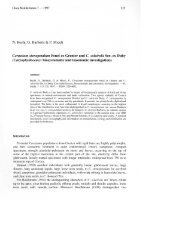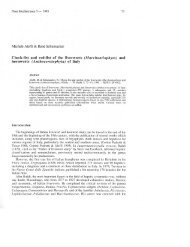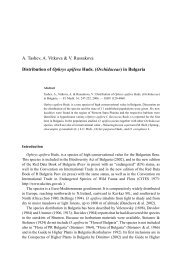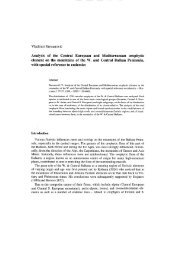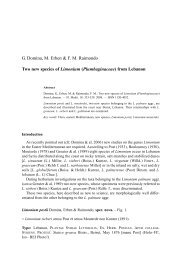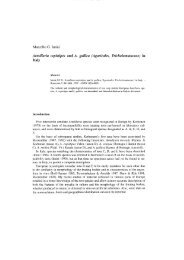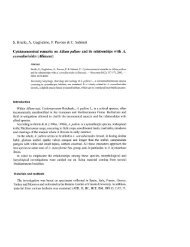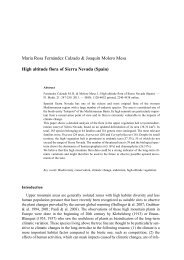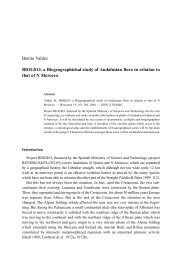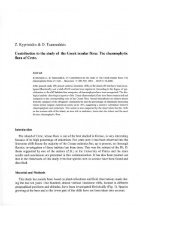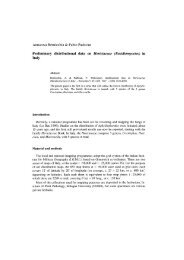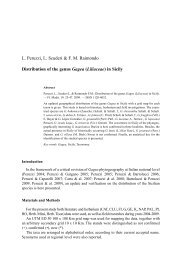Christoph Oberprieler The Systematics of Anthemis L. - Herbmedit.org
Christoph Oberprieler The Systematics of Anthemis L. - Herbmedit.org
Christoph Oberprieler The Systematics of Anthemis L. - Herbmedit.org
You also want an ePaper? Increase the reach of your titles
YUMPU automatically turns print PDFs into web optimized ePapers that Google loves.
44 <strong>Oberprieler</strong>: <strong>Anthemis</strong> in N Africa<br />
This seems to be the first count not only for this species but for <strong>Anthemis</strong> ser. Melampodina<br />
e as a whole. It coincides with nearly all records for A. sect. <strong>Anthemis</strong>. All cells<br />
checked proved to have a small accessory B-chromosome. <strong>The</strong> karyotype resembles that<br />
<strong>of</strong> other species <strong>of</strong> the section, with 5 pairs <strong>of</strong> metacentric, 2 pairs <strong>of</strong> submetacentric, and 2<br />
pairs <strong>of</strong> satellited subtelocentric chromosomes (Table 6). <strong>The</strong> intrachromosomal asymmetry<br />
index AI yielded the highest value <strong>of</strong> all species studied here. A comparably high<br />
value was found only in one population <strong>of</strong> A. confusa from S Tunisia.<br />
Table 6. Chromosomes <strong>of</strong> <strong>Anthemis</strong> melampodina (OTU 12; n = 5).<br />
Chromo- Long arm Short arm Totallength Relative length Arm ratio Chromosome<br />
some pair (Ilm) (Ilm) (Ilm) (%)<br />
type<br />
4.20 3.57 7.77 13.9<br />
Il 3.89 2.97 6.86 12.3<br />
III 4.49 2.19 6.68 12.0<br />
IV 4.86 0.96 6.60 11 .8<br />
V 3.48 2.50 5.98 10.7<br />
VI 3.32 2.41 5.73 10.3<br />
VII 4.11 0.81 5.70 10.2<br />
VIII 3.79 1.79 5.58 10.0<br />
IX 2.98 1.94 4.92 8.8<br />
1.17<br />
1.30<br />
2.05<br />
5.06<br />
1.39<br />
1.37<br />
5.07<br />
2.11<br />
1.53<br />
m<br />
m<br />
sm<br />
st-sat<br />
m<br />
m<br />
st-sat<br />
sm<br />
m<br />
<strong>Anthemis</strong> (subg. <strong>Anthemis</strong>, sect. <strong>Anthemis</strong>) ser. Secundirameae<br />
<strong>Anthemis</strong> confusa<br />
n=9<br />
- Tn, Gafsa, Redeyef - Tamerza, 680 m, 9 May 1994, Vogt 12747 & <strong>Oberprieler</strong> 7052.<br />
- Tn, Sidi-Bouzid, Jelma, 370 m, 17 May 1994, Vogt 13333 & <strong>Oberprieler</strong> 7638.<br />
2n = 18<br />
- Tn, Gafsa, Tozeur - El Oued, 45 m, 9 Apr 1980, Podlech 34145.<br />
*-Tn, Tataouine - Ghomrassen, 340 m, 14 May 1994, Vogt 13131 & <strong>Oberprieler</strong> 7436.<br />
2n = 20<br />
*- Tn, Tataouine - Remada, 450 m, 13 May 1994, Vogt 13049 & <strong>Oberprieler</strong> 7354 (Fig. 4E).<br />
This seems to be the first report <strong>of</strong> chromosome numbers for this species. <strong>The</strong> indications<br />
<strong>of</strong> n = 9 and 2n = 18 agree with all previous reports for members <strong>of</strong> <strong>Anthemis</strong> ser.<br />
Secundirameae. Plants from a population in S Tunisia were found to have an aneuploid<br />
chromosome number <strong>of</strong> 2n = 20, but other plants from that area had the normal chromosome<br />
set with 2n = 18 chromosomes (Table 7). As discussed in the taxonornic part <strong>of</strong> the<br />
present work, Le Houérou (1962) considered plants from this area to be morphologically<br />
intermediate between his A. pedunculata var. decumbens [= A. confusa] and the W Libyan<br />
A. glareosa. However, in the present revision they are assigned to A. confusa not to<br />
A. glareosa. <strong>The</strong> aneuploid chromosome number found in one <strong>of</strong> these plants may be due<br />
to the past or recent interbreeding <strong>of</strong> the two cIosely related species in SE Tunisia.



